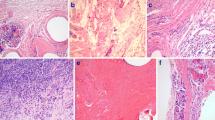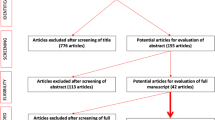Abstract
Introduction and hypothesis
Aim of this study was to investigate the pattern of the foreign body reaction of macroporous polypropylene mesh (MPPM) used in females for the treatment of stress urinary incontinence and to compare this pattern between eroded and noneroded tapes.
Methods
Ten explanted suburethral slings, five eroded and five noneroded, were examined immunohistochemically under light microscopy; the tissue reaction was compared between eroded and noneroded materials.
Results
Eroded material showed a significantly higher accumulation of macrophages around the filaments of the mesh.
Conclusions
This is the first study comparing reaction around eroded and noneroded MPPMs and indicates a more intense tissue reaction around eroded mesh, when compared to noneroded material. More studies are needed to prove whether the detected foreign body reaction was the actual trigger for the erosion.



Similar content being viewed by others
Abbreviations
- SUI:
-
stress urinary incontinence
- MPPM:
-
macroporous polypropylene mesh
- MMP:
-
matrix metalloproteinase
References
Abrams P, Cardozo L, Fall M, Griffiths D, Rosier P, Ulmsten U et al (2003) The standardisation of terminology in lower urinary tract symptoms: report from the Standardisation Subcommittee of the International Continence Society. Urology 61:37–49
Feifer A, Corcos J (2007) The use of synthetic suburethral slings in the treatment of female stress urinary incontinence. Int Urogynecol J 18:1087–1095
Ward K, Hilton P, UK & Ireland TVT Trial Group (2008) Tension-free vaginal tape versus colposuspension for primary urodynamic stress incontinence: 5-year follow-up. BJOG 115:226–233
Stanford E, Paraiso M (2008) A comprehensive review of suburethral sling procedure complications. J Minim Invasive Gynecol 15:132–145
Weyhe D, Belyaev O, Buettner G, Mros K, Mueller C, Meurer K et al (2008) In vitro comparison of three different mesh constructions. ANZ J Surg 78:55–60
Klinge U, Si ZY, Zheng H, Schumpelick V, Bhardwaj R, Klosterhalfen B (2000) Abnormal collagen I to III distribution in the skin of patients with incisional hernia. Eur Surg Res 32:43–48
Krambeck A, Dora C, Sebo T, Rohlinger A, DiMarco D, Elliott D (2006) Time-dependent variations in inflammation and scar formation of six different pubovaginal sling materials in the rabbit model. Urology 67:1105–1110
Yildirim A, Basok E, Gulpinar T, Gurbuz C, Zemheri E, Tokuc R (2005) Tissue reaction of five sling materials and tissue detachment strength of four synthetic mesh materials in a rabbit model. J Urol 174:2037–2040
Elmer C, Bo B, Falconer C, Zhang A, Altman D (2009) Histological inflammatory response to transvaginal polypropylene mesh for pelvic reconstructive surgery. J Urol 181:1189–1195
Woodruff A, Cole E, Dmochowski R, Scarpero H, Beckman E, Winters C (2008) Histologic comparison of pubovaginal sling graft materials: a comparative study. Urology 72:85–89
Meschia M, Pifaroti P, Bernasconi F, Magatti F, Vigano R, Bertozzi R et al (2007) Tension-free vaginal tape and intravaginal slingplasty for stress urinary incontinence: a multicenter randomised trial. Am J Obstet Gynecol 195:1338–1342
Kuschel S, Schuessler B (2008) Results on function and safety of the Safyre-t, a hybrid transobturator vaginal sling for the treatment of stress urinary incontinence. Neurourol Urodyn 27:403–406
Boulanger L, Boukerrou M, Rubod C et al (2008) Bacteriological analysis of meshes removed for complications after surgical management of urinary incontinence or pelvic organ prolapse. Int Urogynecol J 19:827–831
Conflicts of interest
None.
Author information
Authors and Affiliations
Corresponding author
Rights and permissions
About this article
Cite this article
Kavvadias, T., Kaemmer, D., Klinge, U. et al. Foreign body reaction in vaginally eroded and noneroded polypropylene suburethral slings in the female: a case series. Int Urogynecol J 20, 1473–1476 (2009). https://doi.org/10.1007/s00192-009-0974-y
Received:
Accepted:
Published:
Issue Date:
DOI: https://doi.org/10.1007/s00192-009-0974-y




